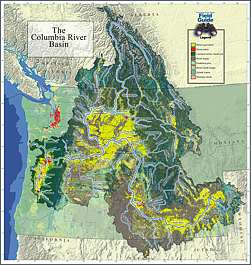|
|
|
Fish &
wildlife |
||||||||||||||||||||||||||||
|
Historically, the Columbia River Basin has supported a rich variety of fish and wildlife, including abundant runs of salmon and steelhead. Between 11 and 16 million wild salmon and steelhead returned from the ocean each year to spawn in rivers and tributaries throughout the 258,500 square miles of the basin. Returning adult fish spawned as far upriver in the Columbia as the headwaters at Columbia Lake, British Columbia, and migrated up the Snake River, the Columbia's largest tributary, as far as Shoshone Falls, 615 miles from the confluence, and more than 900 miles from the Pacific Ocean. Wildlife such as deer, elk, moose, bear, song birds, and other small mammals also populated the basin. Over time, the impact of development, recreation, logging, mining, agriculture, navigation, and the generation of hydroelectric power all combined to disrupt the habitat. By the 1990s, the number of returning fish had declined to about one million annually, and many wildlife populations had also been affected.
The Northwest Power Act of 1980 authorized the states of Idaho, Montana, Oregon, and Washington to form the Northwest Power and Conservation Council. The Council gives the states a voice in deciding their energy future, while also protecting, mitigating, and enhancing the fish and wildlife affected by the dams on the Columbia and Snake rivers. Through the Council's Columbia River Basin Fish and Wildlife Program, a portion of the money the Bonneville Power Administration earns from selling electricity is dedicated to fish and wildlife projects. It is the largest regional effort to protect and enhance fish and wildlife resources in the nation. A critical aspect of the project review and selection process is the use of independent science. The Council conducts a thorough review of proposed projects, including examination by an 11-member panel of independent scientists. The panel analyzes proposed projects using the best scientific knowledge available to determine a project's effectiveness, and evaluates the results of prior-year funded projects to measure their success.
The Council, tribes, state and federal fish and wildlife agencies, and the public also participate in the review and selection process. The Council then recommends projects for funding to Bonneville to implement the program. Funding also goes toward examining important scientific and policy issues. For example, the Council appointed a scientific review team of experts in artificial production to provide an independent assessment of the basin's hatchery programs to improve artificial production and better understand the role such practices should play to recover endangered fish. The program now directs approximately $150 million a year to over 200 projects throughout the basin using a wide variety of approaches: land acquisition to protect and preserve healthy habitats; research to help rebuild naturally spawning populations; construction, operation, and maintenance of fish hatcheries; improvements to passage systems to assist fish movement through and around the dams; restoration efforts to improve spawning and rearing habitats in tributaries; and resident fish programs that mitigate the effects of dams while supporting public fisheries. This brochure highlights four ongoing projects, reviewed by the Council and funded by Bonneville, to help explain the work being done to restore an important part of our Northwest heritage. They are representative of many other projects currently being implemented throughout the basin to benefit fish and wildlife populations. |
|||||||||||||||||||||||||||

